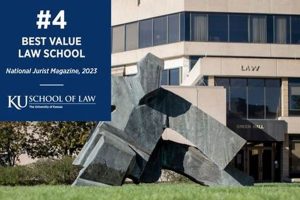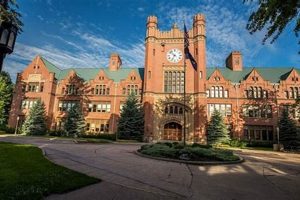Elite training institutions dedicated to ballet offer rigorous programs that cultivate exceptional dancers. These programs often combine intensive technical instruction in various ballet methods with performance opportunities, theoretical studies, and conditioning. Students typically begin training at a young age and dedicate significant time and effort to perfecting their craft.
Access to world-renowned instructors, state-of-the-art facilities, and a competitive yet supportive environment nurtures artistic growth and technical prowess. Historically, certain schools have served as important centers for the development and preservation of ballet traditions, shaping the evolution of the art form and producing generations of influential dancers. Graduates often pursue careers in professional companies, contributing to the rich legacy of ballet worldwide.
This article will explore various factors that contribute to a ballet school’s esteemed reputation, including faculty expertise, curriculum design, performance opportunities, alumni success, and historical significance. Subsequent sections will delve into specific schools recognized for their exceptional training programs and offer insights into the world of elite ballet education.
Tips for Aspiring Ballet Dancers
Pursuing a career in professional ballet requires dedication, discipline, and a strategic approach. These tips offer guidance for aspiring dancers seeking elite training.
Tip 1: Early Training: Begin ballet training at a young age to develop foundational technique and flexibility. Consistent practice from an early stage is crucial for building strength and muscle memory.
Tip 2: Seek Qualified Instruction: Choose reputable schools or instructors with proven track records in developing professional dancers. Look for experienced teachers who offer personalized attention and constructive feedback.
Tip 3: Cross-Training: Supplement ballet training with other forms of exercise like Pilates, yoga, and strength training. This improves overall fitness, prevents injuries, and enhances performance quality.
Tip 4: Develop Artistry: Cultivate artistic expression and musicality alongside technical proficiency. Attend performances, study different ballet styles, and explore other art forms for inspiration.
Tip 5: Embrace Discipline and Resilience: Ballet training is demanding. Cultivate discipline, perseverance, and a positive mindset to overcome challenges and maintain motivation.
Tip 6: Research and Audition: Thoroughly research potential schools and their programs. Prepare diligently for auditions and demonstrate both technical skills and artistic potential.
Tip 7: Network and Learn: Attend workshops, summer intensives, and masterclasses to gain exposure to different teaching styles and network with other dancers and professionals.
By following these tips, aspiring dancers can maximize their potential and increase their chances of success in the competitive world of professional ballet. These strategies foster technical excellence, artistic growth, and the resilience needed to thrive in this demanding yet rewarding field.
The pursuit of excellence in ballet demands unwavering commitment. The following concluding section will reiterate key takeaways and inspire further exploration of this art form.
1. Rigorous Training
Rigorous training is the cornerstone of elite ballet education and a defining characteristic of the world’s best ballet schools. It shapes technical proficiency, artistic development, and the resilience required for a professional career. This demanding approach cultivates not only physical prowess but also the mental fortitude essential for success in this highly competitive field.
- Technical Mastery:
Rigorous training emphasizes the precise execution of ballet technique. Daily classes focus on developing strength, flexibility, coordination, and control. Students undergo intensive drills and exercises to refine their skills in areas such as barre work, center practice, and pointe work. This dedication to technical precision forms the foundation for complex movements and artistic expression, exemplified by the demanding curriculum of schools like the School of American Ballet.
- Disciplined Practice:
A structured and demanding schedule instills discipline and commitment. Students adhere to strict attendance policies and dedicate considerable time to daily classes, rehearsals, and independent practice. This disciplined approach fosters time management skills, work ethic, and the ability to maintain focus under pressure, mirroring the professional demands placed upon dancers in companies like The Royal Ballet.
- Physical and Mental Stamina:
The physically demanding nature of ballet training builds exceptional strength and stamina. Long hours of practice push students to their limits, developing both physical endurance and mental resilience. This ability to withstand rigorous training prepares dancers for the challenges of professional performance, as seen in the intense schedules of schools such as the Bolshoi Ballet Academy.
- Artistic Development:
While technical proficiency is essential, rigorous training also cultivates artistry. Students learn to interpret music, express emotion through movement, and develop their unique artistic voice. This integration of technique and artistry is nurtured through performance opportunities, exposure to diverse choreographic styles, and mentorship from experienced professionals. This holistic approach, often observed in institutions like the Paris Opera Ballet School, produces well-rounded artists capable of captivating audiences.
The rigorous training provided by top ballet schools cultivates the essential qualities for success in professional ballet. The combination of technical mastery, disciplined practice, physical and mental stamina, and artistic development produces dancers capable of meeting the high demands of the art form and contributing to its continued evolution. By fostering these attributes, these institutions play a vital role in shaping the future of ballet.
2. World-class Faculty
A direct correlation exists between world-class faculty and the distinction of a ballet school. Esteemed instructors, often former professional dancers with significant accomplishments, bring a wealth of knowledge, experience, and artistic insight that elevates the quality of education. Their expertise shapes technical proficiency, artistic development, and cultivates the next generation of performers. The presence of renowned teachers attracts aspiring dancers seeking exceptional training, contributing to a school’s prestige and competitive environment. For instance, the Vaganova Ballet Academy’s faculty, steeped in the rich tradition of Russian ballet, continues to produce highly sought-after graduates. Similarly, the Royal Ballet School’s faculty, comprised of distinguished artists and pedagogues, plays a pivotal role in shaping the future of British ballet. This connection underscores the significance of experienced mentorship in nurturing talent and maintaining a school’s position among the world’s best.
World-class faculty members offer more than just technical instruction. They provide invaluable insights into the nuances of performance, artistic interpretation, and the demands of a professional career. Their guidance extends beyond the classroom, shaping students’ artistic sensibilities and fostering a deeper understanding of the art form. The mentorship provided by these experienced professionals often proves crucial in students’ transition from training to professional engagements. Schools like the Paris Opera Ballet School, known for its rigorous training and esteemed faculty, consistently produce dancers who excel in companies worldwide. This success reflects the faculty’s ability to not only impart technical skills but also to cultivate the artistic maturity necessary for a successful career.
The presence of a world-class faculty serves as a key indicator of a ballet school’s commitment to excellence. It reflects an investment in providing students with the highest caliber of instruction and mentorship, contributing to the school’s reputation and attracting promising talent. The enduring legacy of institutions like the School of American Ballet, renowned for its distinguished faculty and alumni, underscores the crucial role of exceptional teachers in shaping the landscape of ballet. Understanding this connection provides valuable insight into the factors that contribute to a ballet school’s esteemed reputation and its ability to produce dancers who excel on the world stage.
3. Performance Opportunities
Performance opportunities represent a crucial element distinguishing top-tier ballet schools. These experiences bridge the gap between training and professional practice, providing invaluable exposure to the demands and realities of the stage. Regular performances cultivate artistry, build confidence, and offer essential feedback for growth. Furthermore, they serve as a platform for students to showcase their skills and potentially attract the attention of company directors and recruiters.
- Stage Experience:
Frequent performance opportunities acclimate students to the unique environment of a professional stage. This includes navigating technical elements like lighting, costumes, and set changes, as well as managing the pressure and adrenaline of performing before an audience. Schools like the Paris Opera Ballet School integrate performance into their curriculum, regularly showcasing student talent in productions ranging from classical repertoire to contemporary works.
- Artistic Development:
Performing allows students to embody different roles and explore diverse choreographic styles. This fosters artistic growth, encourages expressive interpretation, and develops stage presence. Exposure to varying choreographic demands, from the classical ballets presented by the Vaganova Ballet Academy to the innovative contemporary works performed by students at The Juilliard School, expands artistic range and versatility.
- Professional Preparation:
Participating in full-scale productions, including dress rehearsals and technical run-throughs, simulates the professional working environment. This prepares students for the rigorous schedules, collaborative nature, and performance demands of professional companies. The experience gained in student productions at institutions such as the School of American Ballet mirrors the expectations of leading ballet companies.
- Networking and Exposure:
Performances offer a platform for students to be seen by industry professionals, including company directors, choreographers, and recruiters. These opportunities can lead to apprenticeships, company contracts, and valuable networking connections. Schools often invite representatives from prominent companies to attend student performances, providing crucial exposure for graduating students as seen in showcase performances by the Royal Ballet School.
The availability and quality of performance opportunities significantly impact a ballet school’s standing. These experiences are integral to developing well-rounded artists prepared for the challenges and rewards of a professional career. By providing platforms for artistic growth, professional preparation, and industry exposure, leading ballet schools equip their students with the tools necessary to thrive in the competitive world of professional dance. The emphasis on performance underscores a commitment to not only technical training but also the holistic development of future artists.
4. State-of-the-art Facilities
State-of-the-art facilities play a crucial role in distinguishing the best ballet schools worldwide. Optimal training environments directly impact a dancer’s development, influencing technical progress, injury prevention, and overall well-being. These facilities often include spacious studios with sprung floors to minimize impact stress, specialized equipment for conditioning and rehabilitation, and ample resources for performance preparation. The provision of such resources reflects a school’s commitment to providing students with the best possible training experience. Institutions such as the Houston Ballet Academy, known for its advanced facilities, demonstrate a clear understanding of the connection between training environment and student success. Investing in cutting-edge infrastructure allows these schools to attract and nurture top talent, contributing to their global reputation.
Well-designed studios with appropriate flooring, ventilation, and lighting are essential for effective training. Sprung or floating floors absorb impact, reducing stress on joints and minimizing the risk of injury. Access to specialized equipment, such as Pilates reformers and therabands, facilitates targeted conditioning and rehabilitation. Adequate studio space allows for complex choreography and uninhibited movement. Furthermore, access to well-maintained performance spaces, including theaters with professional lighting and sound systems, prepares students for the technical demands of professional productions. The Australian Ballet School, for example, provides students with access to state-of-the-art facilities that support both technical training and performance preparation, contributing to its reputation for producing versatile and well-rounded dancers.
The correlation between state-of-the-art facilities and the quality of ballet education is undeniable. Investing in these resources demonstrates a commitment to student well-being, technical development, and artistic growth. These environments foster optimal learning conditions, minimizing risk and maximizing potential. Schools that prioritize the provision of advanced facilities create a supportive ecosystem where aspiring dancers can thrive. Understanding this connection provides valuable insight into the factors that distinguish leading ballet institutions and contribute to their continued success in shaping the future of dance. The integration of technology, such as video recording and analysis tools, further enhances the training process, enabling precise feedback and individualized instruction. This comprehensive approach reflects a commitment to providing students with the resources necessary to excel in the demanding world of professional ballet.
5. Distinguished Alumni
The presence of distinguished alumni serves as a powerful indicator of a ballet school’s caliber and contributes significantly to its reputation as a world-leading institution. A strong track record of producing successful professional dancers reflects the effectiveness of the school’s training, faculty expertise, and overall educational approach. Distinguished alumni often become influential figures in the dance world, further enhancing their alma mater’s prestige and attracting promising young talent. The success of graduates from schools like the Paris Opera Ballet School, with alumni gracing the stages of major international companies, solidifies its position among the best. Similarly, the prominent careers of dancers trained at the Vaganova Ballet Academy, including legendary figures like Mikhail Baryshnikov, underscore its historical significance and ongoing contribution to the world of ballet. This cyclical relationship between distinguished alumni and institutional reputation creates a self-perpetuating cycle of excellence.
Examining the career paths of distinguished alumni provides valuable insight into a school’s strengths and areas of focus. Whether a school consistently produces dancers who excel in classical repertoire, contemporary works, or choreographic pursuits, the achievements of its graduates offer a tangible measure of its educational impact. For instance, the prevalence of alumni from the School of American Ballet in leading American companies speaks to its focus on developing dancers well-suited to the demands of the American ballet style. Similarly, the international acclaim achieved by graduates of the Royal Ballet School demonstrates its success in cultivating versatile artists capable of thriving in diverse performance contexts. This understanding allows prospective students to assess a school’s suitability based on their own artistic aspirations and career goals.
Distinguished alumni often contribute back to their alma maters through guest teaching, mentorship, or philanthropic support, further strengthening the institution and enriching the educational experience for current students. This connection between past and present generations fosters a sense of community and shared legacy. Moreover, the success of alumni serves as an inspiration to aspiring dancers, demonstrating the transformative power of dedicated training and the potential for achieving professional excellence. Understanding the significance of distinguished alumni provides a crucial perspective on the factors that contribute to a ballet school’s enduring reputation and its ability to shape the future of the art form. This connection highlights the importance of not just technical training, but also the fostering of artistic individuality and the creation of a supportive environment where talent can flourish.
6. Rich Historical Legacy
A rich historical legacy significantly contributes to a ballet school’s prestige and standing within the dance world. It signifies a lasting impact on the art form, often through the development of distinct pedagogical approaches, contributions to ballet technique, and the cultivation of generations of influential artists. This historical context provides a foundation for continued excellence, shaping a school’s identity and informing its approach to training. Understanding a school’s historical legacy offers valuable insight into its values, traditions, and enduring contribution to the art of ballet.
- Development of Pedagogical Approaches:
Many esteemed ballet schools have played a pivotal role in developing and refining pedagogical approaches that have shaped ballet training worldwide. The Vaganova Ballet Academy, for example, is renowned for its codified system developed by Agrippina Vaganova, which emphasizes precise technique, expressiveness, and harmonious coordination. Similarly, the Cecchetti method, originating in Italy, focuses on anatomical principles and efficient movement, influencing ballet training internationally. These distinct pedagogical lineages contribute to a school’s identity and inform its approach to nurturing young talent.
- Influence on Ballet Technique:
Historically significant schools often contribute to the evolution of ballet technique itself. The French School, associated with the Paris Opera Ballet School, is recognized for its elegance, precision, and emphasis on paulement. The Danish School, represented by the Royal Danish Ballet School, is known for its Bournonville style, characterized by light, airy jumps and intricate footwork. These distinct stylistic influences enrich the broader landscape of ballet and provide students with specialized training in specific technical approaches.
- Cultivation of Influential Artists:
A school’s historical legacy is often reflected in the accomplishments of its alumni. The Bolshoi Ballet Academy, with its long history of producing leading dancers for the Bolshoi Ballet, has played a pivotal role in shaping Russian ballet. Similarly, the School of American Ballet’s contribution to American ballet is evident in the numerous alumni who have shaped prominent companies like the New York City Ballet. The success of these dancers reinforces the school’s reputation and attracts future generations of aspiring artists.
- Preservation of Ballet Traditions:
Historically significant schools often serve as custodians of important ballet traditions, preserving classical repertoire and passing down stylistic nuances from one generation to the next. The preservation of these traditions ensures the continuity of the art form and provides students with a deep understanding of ballet’s rich history. Schools like the Vienna State Opera Ballet School, with its roots in the Imperial Ballet, play a vital role in maintaining the historical integrity of classical ballet.
A rich historical legacy provides a foundation for continued excellence, informing a school’s curriculum, teaching methodologies, and artistic values. This historical context shapes a school’s identity and influences its approach to training, contributing to its prestige and attracting students seeking a connection to the rich traditions of ballet. Understanding this connection allows for a deeper appreciation of the factors that distinguish the best ballet schools in the world and their enduring contribution to the art form.
Frequently Asked Questions
This section addresses common inquiries regarding elite ballet training, providing concise and informative responses.
Question 1: What are the typical age requirements for admission to leading ballet schools?
Admission age varies, but many prestigious schools accept students between the ages of 8 and 10 for pre-professional programs. Some institutions offer programs for younger children focused on foundational training.
Question 2: How competitive is the admissions process for these institutions?
Admission to world-renowned ballet schools is highly competitive. Selection criteria typically include demonstrated technical skill, artistic potential, physical suitability, and musicality. Auditions often involve assessments of ballet technique, variations, and improvisational abilities.
Question 3: What is the typical duration of a pre-professional ballet program?
Pre-professional programs generally span several years, often culminating in a diploma or certificate upon completion. The duration can vary depending on the school and the student’s starting age.
Question 4: What are the key factors to consider when choosing a ballet school?
Important factors include faculty expertise, curriculum rigor, performance opportunities, available resources, alumni success, and overall training philosophy. Alignment with a student’s individual learning style and career aspirations should also be considered.
Question 5: What are the career prospects for graduates of top ballet schools?
Graduates of leading ballet schools often pursue careers as professional dancers in renowned companies worldwide. Other career paths may include choreography, teaching, ballet administration, or related fields within the performing arts.
Question 6: What is the role of financial aid and scholarships in accessing elite ballet training?
Many prestigious schools offer financial aid and scholarships based on talent and financial need, recognizing the significant costs associated with elite training. Exploring available funding options is crucial for aspiring dancers seeking access to these programs.
Understanding these common inquiries provides valuable insight into the world of elite ballet training and the considerations involved in pursuing a professional career in dance. Thorough research and careful planning are essential for navigating this challenging yet rewarding path.
This concludes the frequently asked questions section. The following section will offer a concluding perspective on the pursuit of excellence in ballet training.
Conclusion
Elite ballet institutions worldwide share a commitment to rigorous training, world-class faculty, and exceptional performance opportunities. These elements cultivate the technical proficiency, artistic depth, and resilience required for a professional career. Factors such as state-of-the-art facilities, distinguished alumni, and a rich historical legacy further contribute to a school’s reputation and its enduring impact on the art form. Understanding these components provides valuable insight into the landscape of elite ballet education and its ongoing evolution.
The pursuit of excellence in ballet demands dedication, discipline, and a strategic approach to training. Aspiring dancers seeking to reach the highest levels of artistry must embrace the challenges and rewards inherent in this demanding field. The ongoing evolution of ballet relies on the continued dedication of institutions, instructors, and students committed to upholding the highest standards of technical and artistic excellence.







